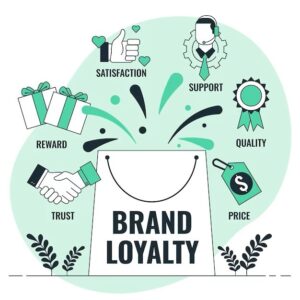
Navigating the Brand Equity Research Landscape: A Comprehensive Guide | Robas Research
Introduction
Welcome to the dynamic world of brand equity, where the heartbeat of your business lies in the perceptions and loyalty of your customers not just products and services. Hence, it’s key to understand the nuances of brand equity research for companies aiming to carve a lasting niche in the market. In this blog, we Robas Research embark on a journey to explore the complexities of Brand Equity Research, disentangling its significance in today’s market and its profound impact on your brand’s perception, customer loyalty, and overall profitability.
What is Brand Equity Research?
Understanding Brand Equity: Brand Equity is not just a buzzword; it’s the measure of your brand’s strength in the market. From awareness to loyalty, it encompasses every aspect that influences how your audience perceives and engages with your brand.
Brand Equity research is a strategic process aimed at understanding and evaluating the perceived value and strength of a brand in the eyes of consumers. This type of research delves into various aspects of a brand, including customer perceptions, attitudes, associations, and overall brand awareness. The ultimate goal of brand equity research is to provide insights that can guide brand management and marketing strategies to enhance the brand’s strength, competitiveness, and overall success in the market. To perform the brand equity research, a Brand Equity Survey is conducted.
Why Brand Equity Research is Important?
Brand equity research is a valuable tool for businesses seeking to build and maintain a strong and favorable brand image in a competitive marketplace.
Strategic Decision-Making (Brand Strategy): Helps businesses make informed decisions regarding brand positioning, marketing communication, and product development.

Competitive Advantage: Identifies opportunities to differentiate the brand from competitors and strengthen its position in the market.
Customer Relationships, Loyalty, and Revenue: Enhances understanding of customer emotions, perceptions, and attitudes associated with a brand. These in turn foster stronger and more meaningful connections with the target audience, improving brand loyalty and ultimately driving revenue.
Market Expansion: Provides insights into potential markets and customer segments where the brand can extend its presence.
Risk Management: Identifies potential risks to the brand’s reputation and allows for proactive measures to mitigate those risks.
The Right Approach
Embarking on a brand equity research expedition demands a meticulous approach. It commences with a clear definition of objectives. What facets of brand equity do you wish to explore? Whether it’s awareness, consideration, relative consideration, loyalty, or usage, clarifying these goals establishes the groundwork for a targeted and effective research strategy.
Key Components of Brand Equity Research
Brand Awareness: Assessing how well consumers recognize or recall a brand, including its name, logo, and key attributes.
Brand Associations: Understanding the positive or negative attributes, values, and characteristics that consumers associate with a brand.
Perceived Quality: Evaluating consumers’ perceptions of the quality and reliability of a brand’s products or services.
Brand Loyalty: Gauging the extent to which consumers are committed to a brand and are likely to choose it repeatedly over competitors.

Brand Value: Determining the perceived worth or value that a brand holds in the marketplace, often related to consumers’ willingness to pay a premium for the brand.

Brand Recognition: Examining how easily consumers can identify a brand when presented with visual or auditory cues.

Brand Perception: Analyzing the overall image and reputation of a brand, considering factors such as trustworthiness, authenticity, and relevance.
Customer Satisfaction: Measuring the level of satisfaction among existing customers and understanding how it contributes to brand loyalty.
The research process typically involves a combination of qualitative and quantitative methods, including surveys, interviews, focus groups, and data analysis. Companies may use established models like Keller’s Customer-Based Brand Equity (CBBE) model or Aaker’s Brand Equity Ten (Aaker Model) to structure and guide their research efforts.
Brand Equity Survey
A brand equity survey is a research tool designed to systematically collect data and insights about consumers’ perceptions, attitudes, and experiences with a specific brand. The survey aims to measure various aspects of brand equity, including all the key components of Brand Equity mentioned above plus the following components. By gathering quantitative and qualitative data, businesses can assess the strength and value of their brand in the eyes of consumers.
Purchase Intent:
Explores respondents’ likelihood to consider, recommend, or purchase the brand in the future.
Can include scenarios to measure potential expansion or new product adoption.
Brand Perception Metrics:
Includes Likert-scale questions to quantify perceptions on a range of factors.
Utilizes metrics like Net Promoter Score (NPS) or Customer Satisfaction (CSAT) to provide numerical indicators.
Demographic and Psychographic Data:
Gathers information about the respondent’s demographics, lifestyle, and preferences to segment and analyze data.
Competitor Comparison:
Compares the brand’s performance in key metrics against competitors. Assesses relative strengths and weaknesses.
Steps to Success
Define Clear Objectives:
The cornerstone of any successful brand equity research lies in precisely articulating your objectives. Are you seeking to measure brand awareness, assess customer loyalty, or evaluate overall brand perception? Clarity in your goals is the first step toward a meaningful research endeavor.
Craft a Robust Methodology:
Tailoring your research methods to align with your objectives is paramount. Surveys, interviews, social media listening—each method offers unique insights. The key is to choose the approach that best captures the essence of your brand and resonates with your audience.
Selecting the Right Model: Keller vs. Aaker
The debate between Keller’s Customer-Based Brand Equity (CBBE) model and Aaker’s Brand Equity Ten (Aaker Model) is one of substance. Evaluating the merits of each model with your research goals is crucial. Keller’s focus on customer perspective and Aaker’s comprehensive model provide distinct advantages, and your choice should align with your specific needs.
The Five Stages of Brand Equity Research
Brand Awareness:
Definition: Brand awareness is the extent to which consumers recognize or recall a brand. It reflects how familiar customers are with a brand and is often considered the initial stage of the customer journey.
Example: Consider a new tech startup launching a revolutionary product. In the brand awareness stage, the goal is to ensure that potential customers are aware of the brand’s existence. This could involve strategic marketing campaigns, social media presence, and outreach efforts to generate visibility.
Definition: Brand consideration involves consumers actively thinking about a brand when making purchasing decisions. It goes beyond mere awareness, indicating that the brand has entered the consideration set of options for a consumer.
Example: Using the same tech startup, after creating awareness, the next step is to position the brand as a viable option. This could involve highlighting unique features, benefits, or conducting comparative advertising to showcase the brand’s value compared to competitors.
Relative Consideration (Aided Consideration):
Definition: Relative consideration involves evaluating a brand in relation to its competitors. It assesses how the brand measures up against others in the eyes of consumers, considering various attributes and factors.
Example: Continuing with the tech startup, in the relative consideration stage, the focus shifts to demonstrating the brand’s advantages over competitors. This could involve customer testimonials, expert reviews, and highlighting key differentiators to sway consumers in favor of the brand.
Brand Loyalty and Usage:
Definition: Brand loyalty signifies a consumer’s commitment and preference for a particular brand. It goes beyond consideration, indicating a repeated choice of the brand over time. Brand usage, on the other hand, reflects the frequency with which consumers engage with and use the brand’s products or services.
Example: Assuming the tech startup successfully navigated the previous stages, the goal is to convert consideration into loyalty and usage. Loyalty programs, excellent customer service, and consistently meeting customer expectations contribute to building brand loyalty and increasing usage.
Brand Perception:
Definition: Brand perception encompasses the overall image, feelings, and associations that consumers have with a brand. It’s influenced by the cumulative experiences and interactions a consumer has with the brand across all touchpoints.
Example: Building on the tech startup scenario, brand perception is about ensuring that customers associate positive attributes with the brand. This could involve maintaining a strong online presence, responding effectively to customer feedback, and aligning marketing messages with the brand’s core values.
In summary, the five stages of Brand Equity research provide a comprehensive framework for understanding the customer journey. From creating initial awareness to fostering loyalty and shaping brand perception, each stage plays a vital role in building a strong and resilient brand in the market.
Common Mistakes of Brand Equity Research and How to Avoid Them
Lack of Clarity in Objectives
Ambiguity in research goals can result in inconclusive findings. Clearly defining your objectives ensures that the insights gained are actionable and aligned with your business strategy.
Ignoring the Human Element
At its core, brand equity is a human experience—built on emotions and perceptions. Neglecting this human element can lead to a skewed understanding of your brand’s true impact.
Overlooking Consistency
Consistency in brand messaging across various touchpoints is paramount. Inconsistencies can dilute brand equity, and therefore, a unified brand image should be maintained to reinforce the desired perceptions.
Real-Life Example of Brand Equity Research
Imagine a global tech giant, eager to revitalize its brand strategy. Through a comprehensive Brand Equity Research initiative, the company identified a significant gap in awareness among its target demographic. Armed with this invaluable insight, the company strategically implemented targeted marketing campaigns, resulting in a notable increase in brand awareness and heightened customer engagement.
Conclusion
Brand Equity Research is not merely a tool; it is the key to unlocking the full potential of your brand in a crowded marketplace. With a strategic approach, the right methodology, and a deep understanding of customer perceptions, businesses can confidently navigate the competitive landscape. Let Robas Research be your guiding force in identifying the secrets to building and enhancing brand equity, ensuring your brand stands out and remains resilient, revered, and resonant in the continuously evolving business landscape.
FAQs
Q1: What is Brand Equity, and why is it crucial now?
Brand Equity is the amalgamation of brand strength, value, and customer loyalty. In today’s competitive landscape, understanding and enhancing your brand’s equity is critical for standing out and thriving.
Q2: How long does it typically take to conduct Brand Equity Research?
The duration of a Brand Equity Research study varies based on the scope and objectives. A comprehensive research effort may take several weeks to months, considering the need for data collection, analysis, and strategic planning based on the findings.
Q3: What role do customer interviews play in Brand Equity Research?
Customer interviews are invaluable for gaining qualitative insights into customer perceptions and emotions. They provide a deeper understanding of the nuances behind the quantitative data, offering a more comprehensive view of a brand’s equity.
Q4: How can a company ensure consistency in brand messaging across diverse touchpoints?
Consistency in brand messaging requires a well-defined brand strategy and clear communication guidelines. Regular training sessions for employees, brand style guides, and monitoring of marketing materials contribute to maintaining a unified brand image.
Q5: Is Brand Equity Research a one-time effort or an ongoing process?
While a comprehensive study can be conducted as a one-time effort, brand equity is dynamic and can change over time. Regular monitoring and periodic reassessment ensure that the brand strategy remains aligned with evolving market trends and consumer expectations.
Q6: How does Brand Equity affect sales and profitability?
Brand Equity has a direct impact on consumer decisions, influencing market share and, consequently, profit margins. A strong brand attracts and retains customers, driving sales and enhancing overall profitability.
Q7: What are the steps of Brand Equity Research?
Brand Equity Research involves defining clear objectives, selecting the right model, and navigating through stages like awareness, consideration, relative consideration, loyalty, and usage. Each step contributes to a comprehensive understanding of your brand’s equity.
Q8: Can you elaborate on the components of Brand Equity?
Brand Equity comprises brand associations, perceived brand value, and customer loyalty. These components collectively shape how consumers perceive and connect with your brand.


